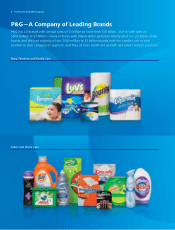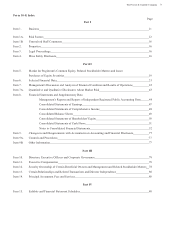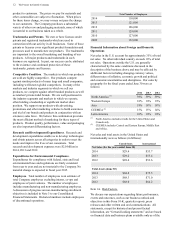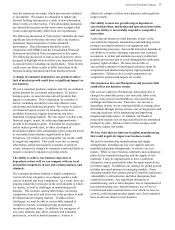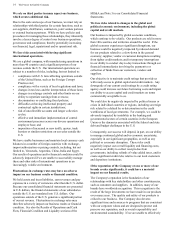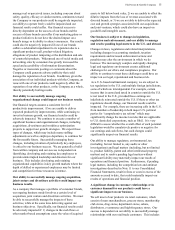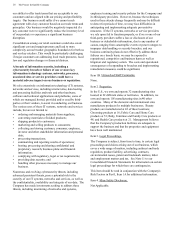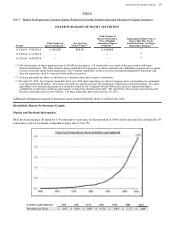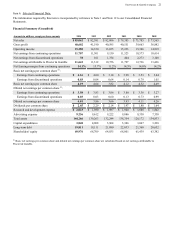Proctor and Gamble 2014 Annual Report Download - page 18
Download and view the complete annual report
Please find page 18 of the 2014 Proctor and Gamble annual report below. You can navigate through the pages in the report by either clicking on the pages listed below, or by using the keyword search tool below to find specific information within the annual report.
16 The Procter & Gamble Company
our ability to offer trade terms that are acceptable to our
customers and are aligned with our pricing and profitability
targets. Our business could suffer if we cannot reach
agreement with a key customer based on our trade terms and
principles. Our business would be negatively impacted if a
key customer were to significantly reduce the inventory level
of our products or experience a significant business
disruption.
Consolidation among our retail customers could also create
significant cost and margin pressure and lead to more
complexity across broader geographic boundaries for both us
and our key retailers. This would be particularly challenging
if major customers are addressing local trade pressures, local
law and regulation changes or financial distress.
A breach of information security, including a
cybersecurity breach or failure of one or more key
information technology systems, networks, processes,
associated sites or service providers could have a
material adverse impact on our business or reputation.
We rely extensively on information technology (IT) systems,
networks and services, including internet sites, data hosting
and processing facilities and tools and other hardware,
software and technical applications and platforms, some of
which are managed, hosted, provided and/or used by third-
parties or their vendors, to assist in conducting our business.
The various uses of these IT systems, networks and services
include, but are not limited to:
• ordering and managing materials from suppliers;
• converting materials to finished products;
• shipping products to customers;
• marketing and selling products to consumers;
• collecting and storing customer, consumer, employee,
investor and other stakeholder information and personal
data;
• processing transactions;
• summarizing and reporting results of operations;
• hosting, processing and sharing confidential and
proprietary research, business plans and financial
information;
• complying with regulatory, legal or tax requirements;
• providing data security; and
• handling other processes necessary to manage our
business.
Numerous and evolving cybersecurity threats, including
advanced persistent threats, pose a potential risk to the
security of our IT systems, networks and services, as well as
the confidentiality, availability and integrity of our data. The
Company has made investments seeking to address these
threats, including monitoring of networks and systems,
employee training and security policies for the Company and
its third-party providers. However, because the techniques
used in these attacks change frequently and may be difficult
to detect for periods of time, we may face difficulties in
anticipating and implementing adequate preventative
measures. If the IT systems, networks or service providers
we rely upon fail to function properly, or if we or one of our
third-party providers suffer a loss or disclosure of our
business or stakeholder information, due to any number of
causes, ranging from catastrophic events or power outages to
improper data handling or security breaches, and our
business continuity plans do not effectively address these
failures on a timely basis, we may be exposed to
reputational, competitive and business harm as well as
litigation and regulatory action. The costs and operational
consequences of responding to breaches and implementing
remediation measures could be significant.
Item 1B. Unresolved Staff Comments.
None.
Item 2. Properties.
In the U.S., we own and operate 32 manufacturing sites
located in 22 different states or territories. In addition, we
own and operate 105 manufacturing sites in 40 other
countries. Many of the domestic and international sites
manufacture products for multiple businesses. Beauty
products are manufactured at 42 of these locations;
Grooming products at 16; Fabric Care and Home Care
products at 53; Baby, Feminine and Family Care products at
48; and Health Care products at 21. Management believes
that the Company's production facilities are adequate to
support the business and that the properties and equipment
have been well maintained.
Item 3. Legal Proceedings.
The Company is subject, from time to time, to certain legal
proceedings and claims arising out of our business, which
cover a wide range of matters, including antitrust and trade
regulation, product liability, advertising, contracts,
environmental issues, patent and trademark matters, labor
and employment matters and tax. See Note 11 to our
Consolidated Financial Statements for information on certain
legal proceedings for which there are contingencies.
This item should be read in conjunction with the Company's
Risk Factors in Part I, Item 1A for additional information.
Item 4. Mine Safety Disclosure.
Not Applicable.


